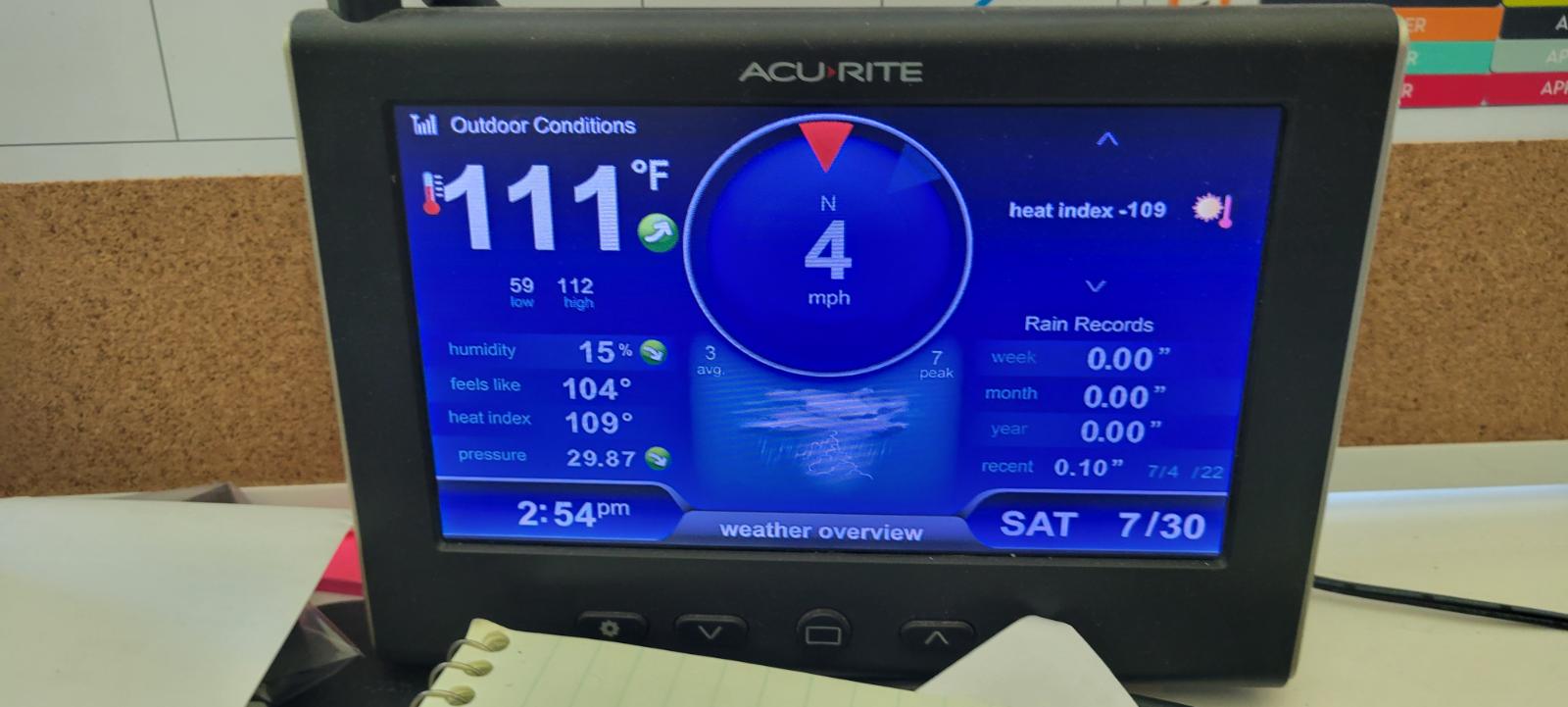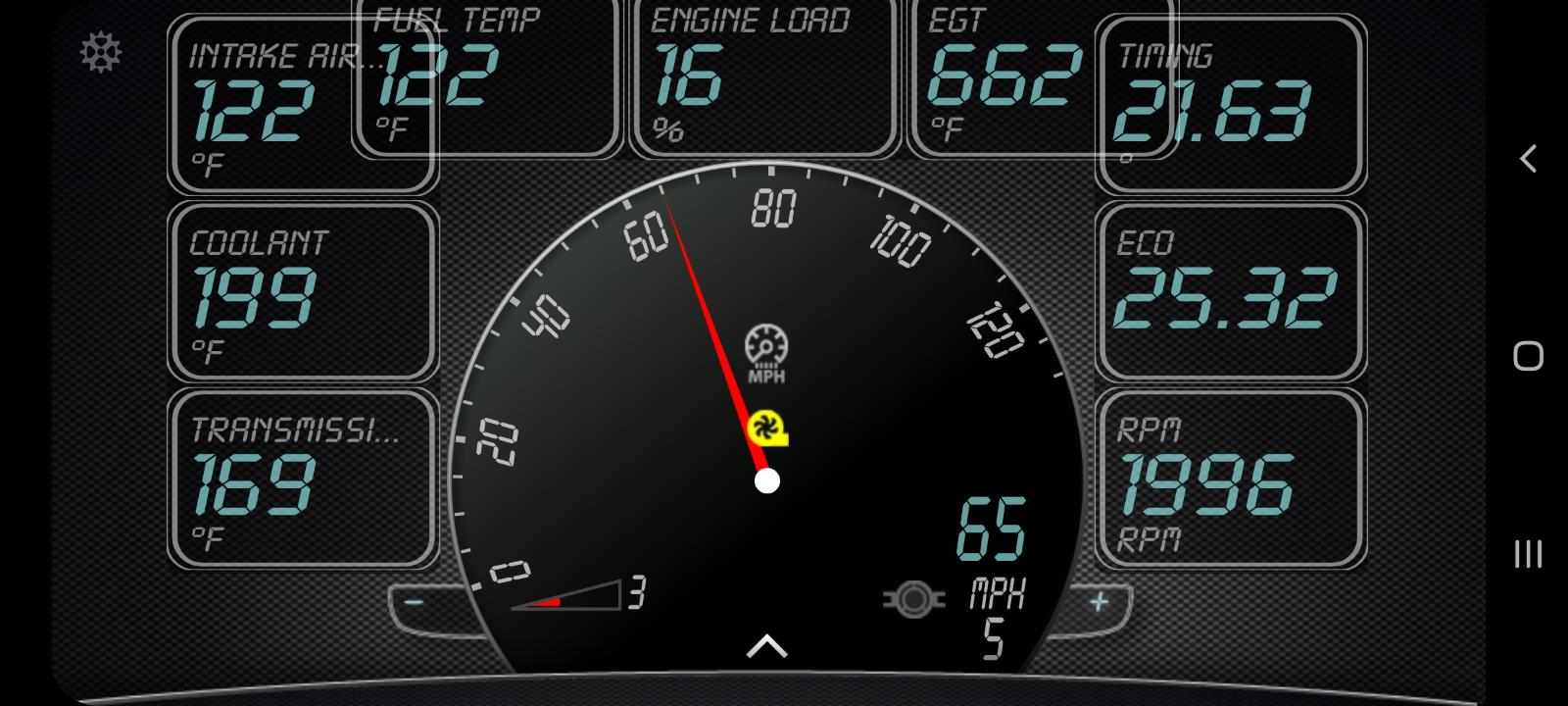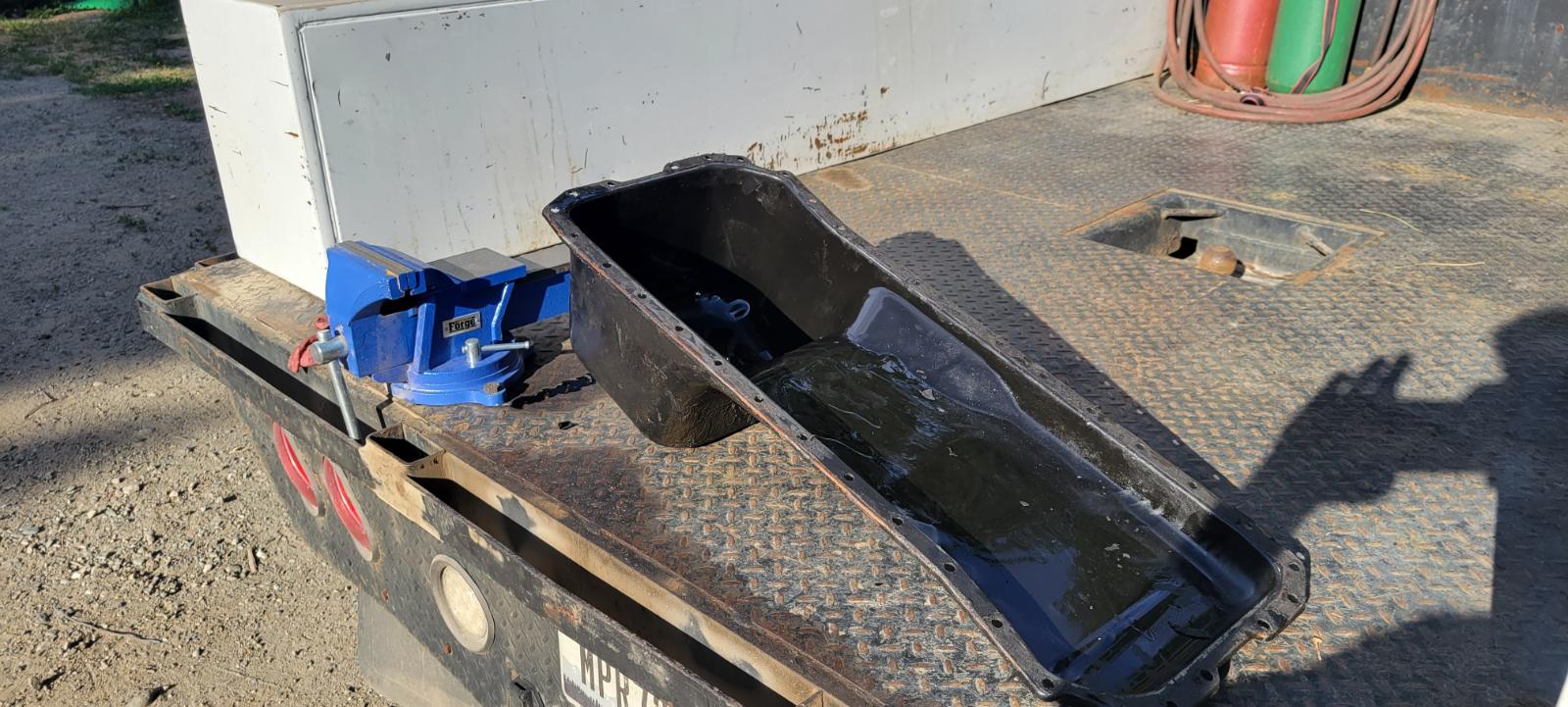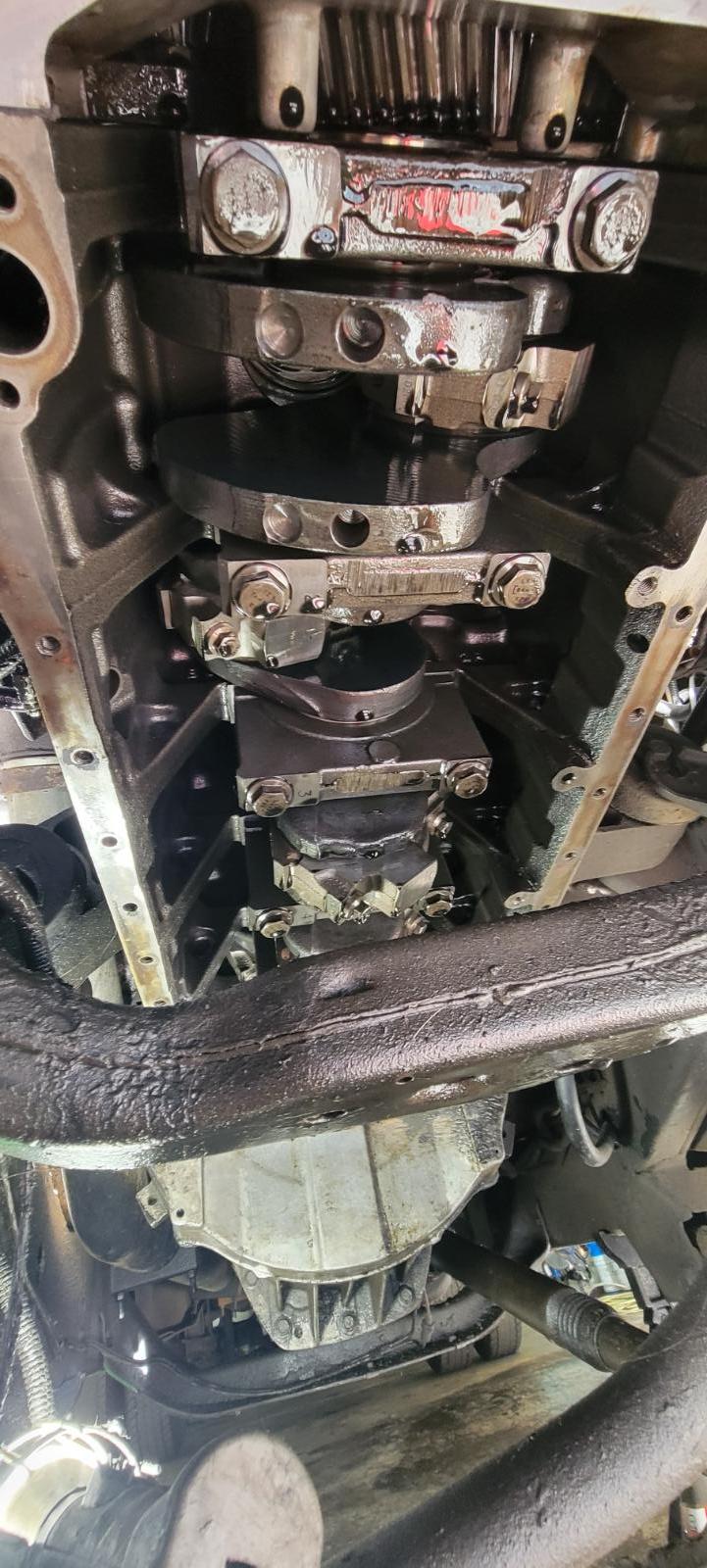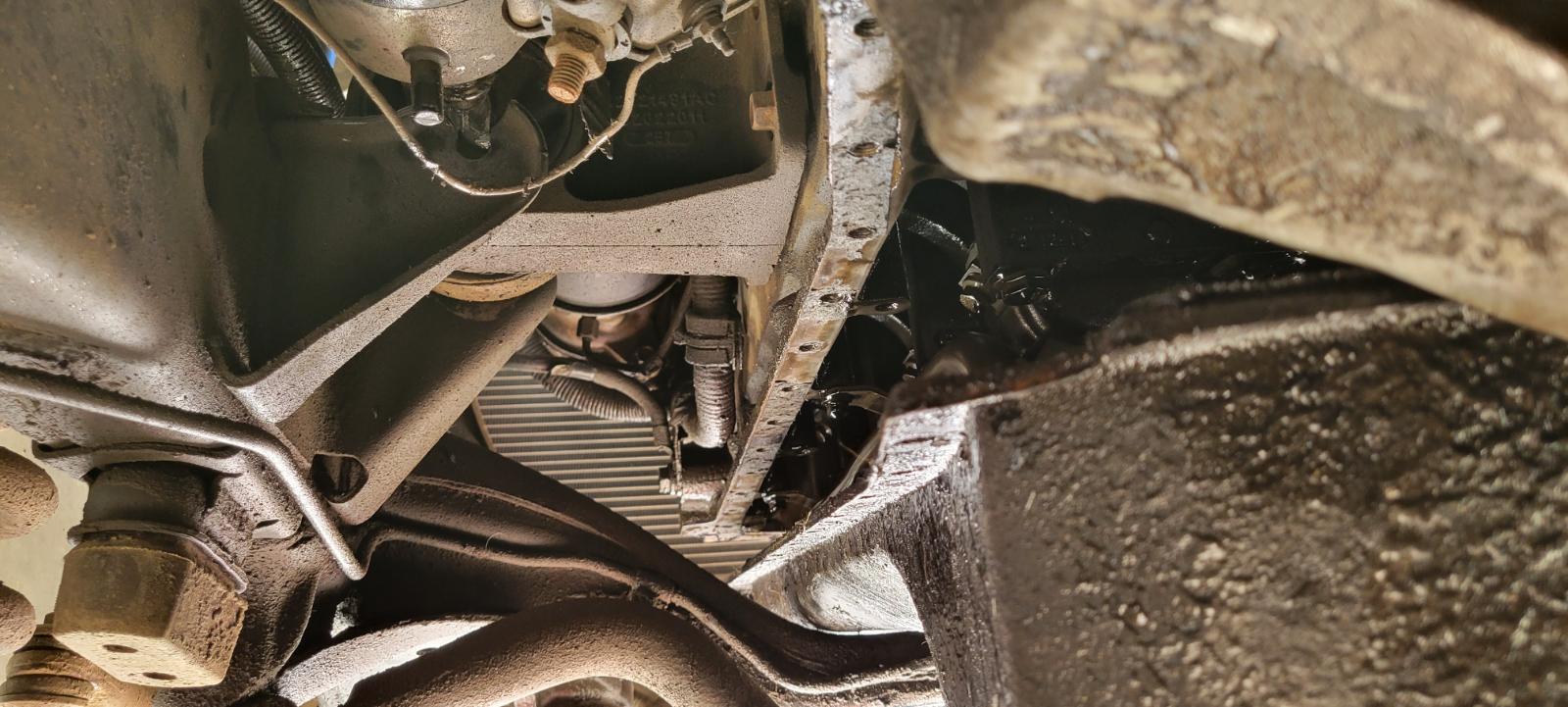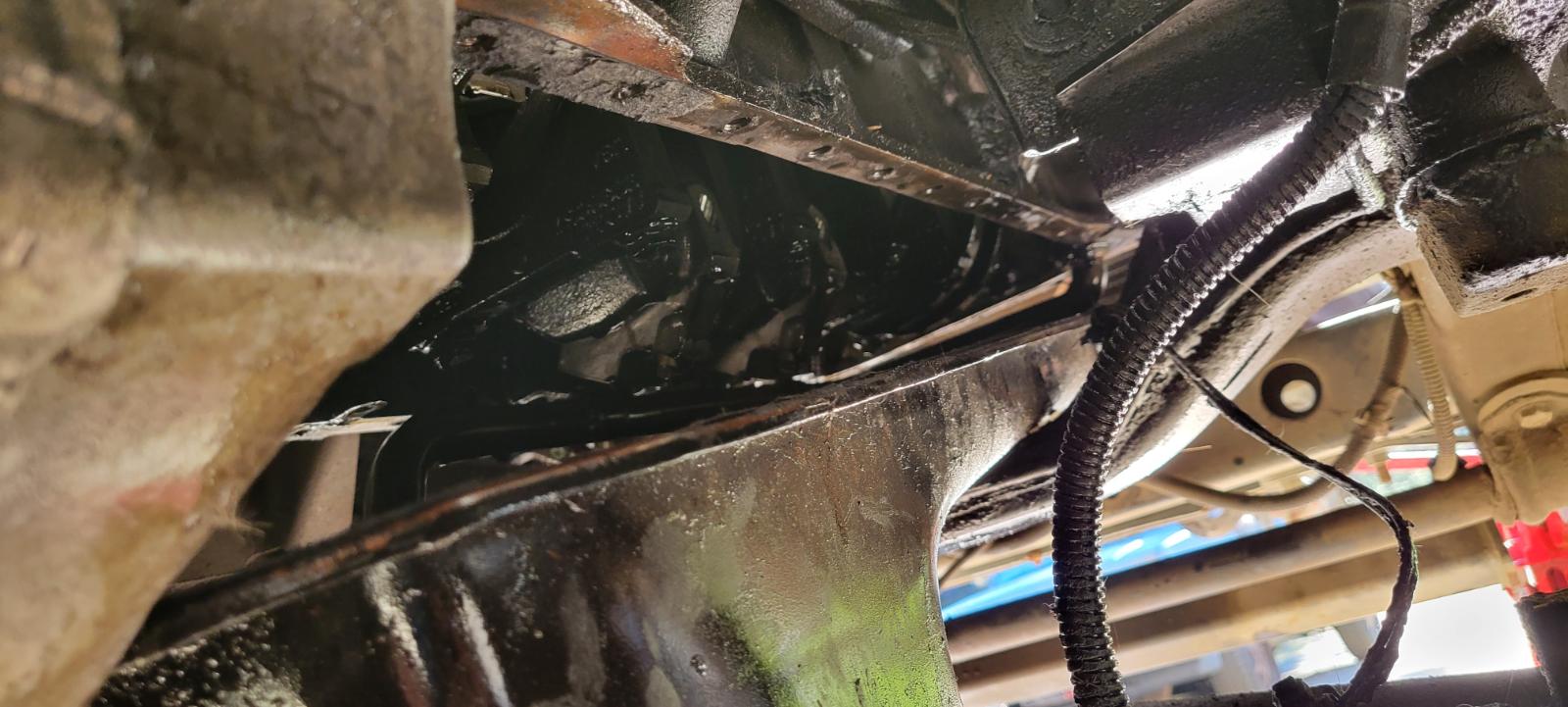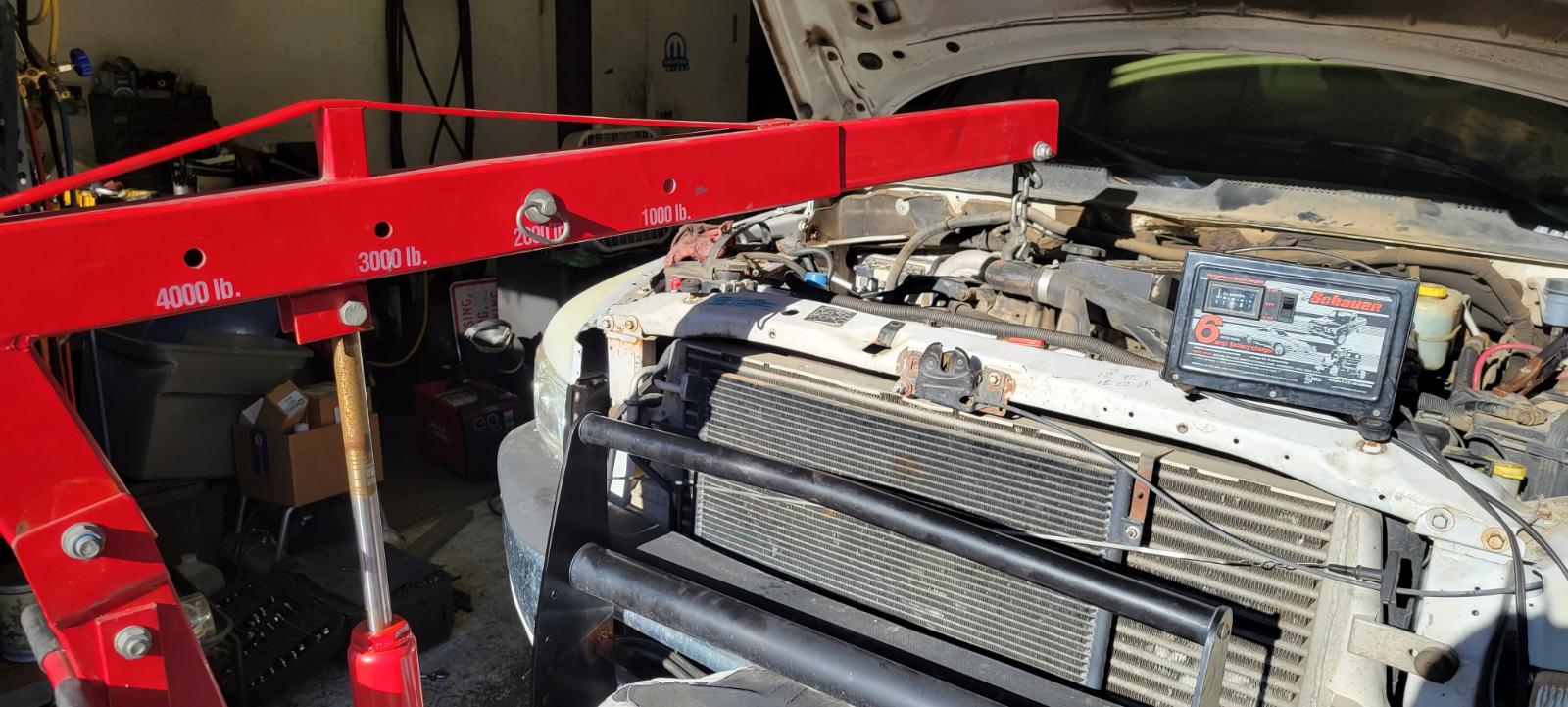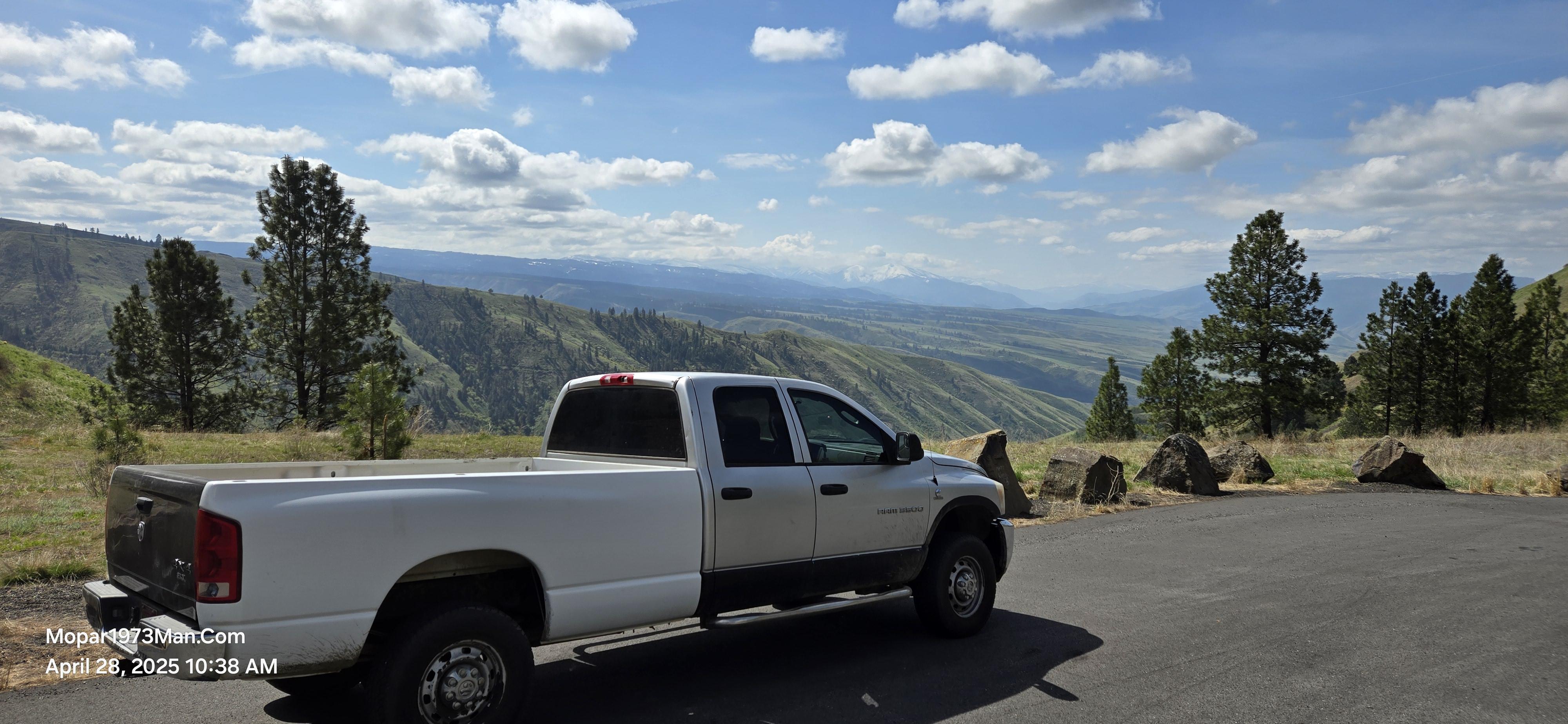
Everything posted by Mopar1973Man
-
Yet another setback. It's always something
Hey! Don't be giving away all my secrets.
-
Hydro Boost
Ouch. If your hydrobooster is leaking into the cab you should go to Pirate Jack's and get the seal kit for the hydrobooster. The input seal might require cutting the rod and weld it back together being the pedal eye won't allow it to pass.
-
Yet another setback. It's always something
Get it fixed. Life sucks when you are in constant pain.
-
Engine Oil Pan Gasket Replacement
I know most of you have looked at your oil pan and wondered if the oil pan can be removed easily. The answer is yes. You can remove the oil pan completely but you will need a few heavy-duty tools like a bottle jack or an engine hoist. The first thing you going to need to do is jack up the truck so the axle hangs freely. Then you want to drain all the oil from the pan. In my case, I had to do tie rod ends and a new drag link so this was all removed. I removed the wheels from the axle and allowed the axle to just hang freely. Loosen up both engine mounts bolts till the nuts are to the end of the threads. Now set up an engine hoist and hook it to the front hoist ring of the block. Lift the engine carefully watching the fan and clearance of everything. Once the engine is lifted remove all the 10mm bolts in the oil pan. Using a putty knife pry the pan free from the block. There will be plenty of room to slide the pan around and loosen the two 10mm bolts that hold the pickup tube on the driver side of the block and then the two bolts in the flange of the pickup tube. At this point, there is nothing holding the pan in place, and should about fall out the rear of the engine. You will be able to scrap the bottom of the block clean with a putty knife and then scrap and wash the oil pan clean. The gasket I used was from NAPA. The oil pickup tube part of the gasket is perforated so it can be cut free from the main oil pan gasket. I opted to do so because I wanted to glue the pan gasket to the pan using grey RTV silicone. Then a thin coat of grey RTV on the pickup tube flange too. Once it is mostly cured up you can place the pickup tube in the pan and slide it back into position. You are going to install the pickup tube bolts first and mount them all back together this will help in holding the oil pan in place again. Now you can start hand installing all the pan bolts back into the oil pan and hand torque them once all the bolts are installed.
- 7 comments
- 2 reviews
-
-

- 3
-
-
Engine Article - Engine Oil Pan Gasket Replacement
I know most of you have looked at your oil pan and wondered if the oil pan can be removed easily. The answer is yes. You can remove the oil pan completely but you will need a few heavy-duty tools like a bottle jack or an engine hoist. The first thing you going to need to do is jack up the truck so the axle hangs freely. Then you want to drain all the oil from the pan. In my case, I had to do tie rod ends and a new drag link so this was all removed. I removed the wheels from the axle and allowed the axle to just hang freely. Loosen up both engine mounts bolts till the nuts are to the end of the threads. Now set up an engine hoist and hook it to the front hoist ring of the block. Lift the engine carefully watching the fan and clearance of everything. Once the engine is lifted remove all the 10mm bolts in the oil pan. Using a putty knife pry the pan free from the block. There will be plenty of room to slide the pan around and loosen the two 10mm bolts that hold the pickup tube on the driver side of the block and then the two bolts in the flange of the pickup tube. At this point, there is nothing holding the pan in place, and should about fall out the rear of the engine. You will be able to scrap the bottom of the block clean with a putty knife and then scrap and wash the oil pan clean. The gasket I used was from NAPA. The oil pickup tube part of the gasket is perforated so it can be cut free from the main oil pan gasket. I opted to do so because I wanted to glue the pan gasket to the pan using grey RTV silicone. Then a thin coat of grey RTV on the pickup tube flange too. Once it is mostly cured up you can place the pickup tube in the pan and slide it back into position. You are going to install the pickup tube bolts first and mount them all back together this will help in holding the oil pan in place again. Now you can start hand installing all the pan bolts back into the oil pan and hand torque them once all the bolts are installed. View full Cummins article
-
Custom AirDog Install
Custom AirDog 150 Install Doing a custom AirDog install I think the hardest thing that people struggle with is getting the draw straw installed properly in the proper place. First of the draw straw should not be installed in the sender basket. The reason is the return fuel from the rear of the head is heated by the heat of the head and that will be the first fuel you going to pump back to the VP44. We all know that you want cool fuel for the VP44 this is a bad idea. Second, your draw straw needs to be installed in the fuel tank away from the sender where the hot fuel is returned. I typically use the high spot just forward of the sender which typically has no other interference from the bed or frame. Installing the Draw Straw First off you need to drop the tank and have it fully drained of fuel. It is a requirement to have the tank completely empty of fuel when the measurements are done for the straw. Diesel fuel weighs about 6 pounds per gallon so when you fill the tank the bottom will deflect more opening the gap more between the straw tip and the bottom this is why the gap must be 1 or 2 quarter coins at most. Then place the fuel tank on 2x4 boards under where the bands normally sit to keep from deflecting the bottom of the tank upwards which will skew your draw straw measurement. When you drill the 1-inch hole do it in a place like I mention the high spot forward of the sender. Using either 1 or 2 quarters place them under the tip of the Draw Straw so you can mark the proper amount to trim off. Now remove the straw and measure the same distance from the tip and mark and cut. When you cut the straw make sure to cut it straight! NO ANGLE CUTS!... MUST BE CUT STRAIGHT. Now install your Draw Straw you'll need the gasket on first. Then install the straw then the flat washer, star washer, and the nut on the inside. Tighten the nut, yeah it's not easy to tighten that nut on the inside. Then add your fitting to the straw when you do make sure to face it so you can hook up the fuel lines. Mounting the AirDog 150 pump to the frame When I now install the pump I did not use the supplied bracket for mounting the AirDog sandwiched to the frame this typically ends up with the filters hanging below the frame line and striking damage might occur if you use your truck offroad. This is why I use the base bracket and mark and drill the frame for placement so the filters are above the frame line. In this case, I mounted the AirDog 150 on the outside of the frame. Now you want to drill and tap the frame for the bracket. I used a drill just a bit small but the 5/16-18 tap requires a 17/64 drill bit. Once holes are drilled and tapped then you need the four Allen bolts supplied in the kit and the plastic block spacer. Tighten up the four bolts and then install the AirDog in the bracket. Installing fuel Lines / Hoses Since this truck has a flatbed and modified filler neck. I had taken advantage of the custom filler neck for my return line coupler. I pulled out the double barbed fitting and replaced it with the AirDog return fitting. Then I measured from the AirDog 150 return fitting to the return barb. Cut the hose. Now use some lightweight oil and lube each push lock fitting and push them into the hose. The easiest way is to put the fitting on the floor and push down on the fitting with the hose. All you got to do after the hose is put together with both fittings is snap it on each fitting at the return and the pump. Now Supply from the tank you measure from there and route back to the pump. The same applies here cut to length and then push your push lock fittings into the hose. Then snap on the draw straw and the AirDog. Now the feed line to the engine is a bit different than most do. I route the feed line over the frame and then run the hose inside the frame all the way forward to the hole near the bell housing. They exit the frame and run to the stock Fuel Filter housing. For this one you have to push the fitting on by hand being the hose is run in the frame already. Again just snap the hose onto the AirDog pump and then on the stock fuel filter. Now I ordered the optional Big Line Kit which goes between the stock fuel filter housing and the VP44. The stock filter housing is always kept when I do an AirDog install. The extra filter does catch things that the AirDog misses. The stock fuel filter heater helps for wintertime operation. I highly suggest you always keep the stock fuel filter housing. Electrical / Wiring The AirDog kit comes with all the electrical and fuse hook-up. Again this is all ran back through the frame with the fuel lines to prevent snagging electrical while offroad. I typically mount the relay to the cowl using the ground screw of the wipers on the driver side. The positive and negative hook-up will require trimming there are over 6 feet of excess wiring there. I do NOT hook to the battery ever. I hook the ground to the bolt of the PDC for ground. The positive line I hook up to the PDC positive post. This way there is no wiring that will be damaged by battery acid. Then you need to unhook the factory lift pump lead and hook up the AirDog signal lead to the factory lead.
-
Fuel Article - Custom AirDog Install
Custom AirDog 150 Install Doing a custom AirDog install I think the hardest thing that people struggle with is getting the draw straw installed properly in the proper place. First of the draw straw should not be installed in the sender basket. The reason is the return fuel from the rear of the head is heated by the heat of the head and that will be the first fuel you going to pump back to the VP44. We all know that you want cool fuel for the VP44 this is a bad idea. Second, your draw straw needs to be installed in the fuel tank away from the sender where the hot fuel is returned. I typically use the high spot just forward of the sender which typically has no other interference from the bed or frame. Installing the Draw Straw First off you need to drop the tank and have it fully drained of fuel. It is a requirement to have the tank completely empty of fuel when the measurements are done for the straw. Diesel fuel weighs about 6 pounds per gallon so when you fill the tank the bottom will deflect more opening the gap more between the straw tip and the bottom this is why the gap must be 1 or 2 quarter coins at most. Then place the fuel tank on 2x4 boards under where the bands normally sit to keep from deflecting the bottom of the tank upwards which will skew your draw straw measurement. When you drill the 1-inch hole do it in a place like I mention the high spot forward of the sender. Using either 1 or 2 quarters place them under the tip of the Draw Straw so you can mark the proper amount to trim off. Now remove the straw and measure the same distance from the tip and mark and cut. When you cut the straw make sure to cut it straight! NO ANGLE CUTS!... MUST BE CUT STRAIGHT. Now install your Draw Straw you'll need the gasket on first. Then install the straw then the flat washer, star washer, and the nut on the inside. Tighten the nut, yeah it's not easy to tighten that nut on the inside. Then add your fitting to the straw when you do make sure to face it so you can hook up the fuel lines. Mounting the AirDog 150 pump to the frame When I now install the pump I did not use the supplied bracket for mounting the AirDog sandwiched to the frame this typically ends up with the filters hanging below the frame line and striking damage might occur if you use your truck offroad. This is why I use the base bracket and mark and drill the frame for placement so the filters are above the frame line. In this case, I mounted the AirDog 150 on the outside of the frame. Now you want to drill and tap the frame for the bracket. I used a drill just a bit small but the 5/16-18 tap requires a 17/64 drill bit. Once holes are drilled and tapped then you need the four Allen bolts supplied in the kit and the plastic block spacer. Tighten up the four bolts and then install the AirDog in the bracket. Installing fuel Lines / Hoses Since this truck has a flatbed and modified filler neck. I had taken advantage of the custom filler neck for my return line coupler. I pulled out the double barbed fitting and replaced it with the AirDog return fitting. Then I measured from the AirDog 150 return fitting to the return barb. Cut the hose. Now use some lightweight oil and lube each push lock fitting and push them into the hose. The easiest way is to put the fitting on the floor and push down on the fitting with the hose. All you got to do after the hose is put together with both fittings is snap it on each fitting at the return and the pump. Now Supply from the tank you measure from there and route back to the pump. The same applies here cut to length and then push your push lock fittings into the hose. Then snap on the draw straw and the AirDog. Now the feed line to the engine is a bit different than most do. I route the feed line over the frame and then run the hose inside the frame all the way forward to the hole near the bell housing. They exit the frame and run to the stock Fuel Filter housing. For this one you have to push the fitting on by hand being the hose is run in the frame already. Again just snap the hose onto the AirDog pump and then on the stock fuel filter. Now I ordered the optional Big Line Kit which goes between the stock fuel filter housing and the VP44. The stock filter housing is always kept when I do an AirDog install. The extra filter does catch things that the AirDog misses. The stock fuel filter heater helps for wintertime operation. I highly suggest you always keep the stock fuel filter housing. Electrical / Wiring The AirDog kit comes with all the electrical and fuse hook-up. Again this is all ran back through the frame with the fuel lines to prevent snagging electrical while offroad. I typically mount the relay to the cowl using the ground screw of the wipers on the driver side. The positive and negative hook-up will require trimming there are over 6 feet of excess wiring there. I do NOT hook to the battery ever. I hook the ground to the bolt of the PDC for ground. The positive line I hook up to the PDC positive post. This way there is no wiring that will be damaged by battery acid. Then you need to unhook the factory lift pump lead and hook up the AirDog signal lead to the factory lead. View full Cummins article
-
How hot are you?
Heck, we are starting out at 60*F this morning and already 90*F at 11:30am.
-
How hot are you?
Yeah way toasty. Morning started at 59°F and topped out at 112°F. Too hot to be out in the heat.
-
How hot are you?
-
Fel Pro head gasket gave up in 4k miles
No worse than 1k miles and blow a Cummins OE head gasket and have it come apart in several places. No, Cummins does not produce gaskets, a company named BLK does for Cummins.
-
Fuel Return To Tank (not basket) Question
-
Oil Pan Gasket Replacement Advice Request
Gasket I'm not worried about. It's the pan bolt lip. The last one to installed the pan over torqued the bolts and dimpled all the bolt holes. Now ive gotta peen the holes back the other direction so the pan is flat again.
-
Oil Pan Gasket Replacement Advice Request
Make sure you get a tube of grey RTV silicone. The NAPA gasket the oil pickup gasket can be separated which your going to need to do. You can lightly silicone the pan apply the gasket. Then when the pan goes back up you'll need to install the oil pick up and its gasket first then the oil pan last.
-
Oil Pan Gasket Replacement Advice Request
Ha ******... Yes you can remove the pan without pullin the trans. Just drop the front axle so it hangs, the lift the engine 3 inches. Pull the pick up tube. Out it comes.
-
Oil Pan Gasket Replacement Advice Request
Pull the transmission and the oil pan would come out.
-
Fuel Return To Tank (not basket) Question
Copper should not be used. The following conditions accelerate diesel's aging process: Contact with zinc, copper, or metal alloys that contain zinc or copper. These metals react with diesel and form unstable compounds, which means there is higher potential for dangerous chemical reactions like explosions.
-
Vacuum pump issue I think
This is why the old term holds true... "Use It Or Lose It" Mine was installed back at 20k miles and currently I'm at 449k miles and it's still working. I use it daily.
-
Vacuum pump issue I think
The butterfly valve. Typically the brake is junk.
-
Oil Pan Gasket Replacement Advice Request
Since I'm doing tie rods all that out of the way makes it a bit more room to get the pan cleaned up.
-
Oil Pan Gasket Replacement Advice Request
. Lifted the engine just enough so I can scrape off the old gasket. Both engine mounts are 22mm. It's going to be fun to slip the gasket in.
-
Sneak peek on how to custom install a AirDog 150 article
Should be fixed now...
-
Vacuum pump issue I think
Me personally I would replace all vacuum lines making sure there is no cracked plastics or fittings. Even if you used a different hose and hooked from the vacuum pump and directly to the exhaust brake it should move. If not iveseen exhaust brakes that have seized from lack of use.
-
Oil Pan Gasket Replacement Advice Request
I'll be doing a pan gasket on this truck in my shop. I'm not going to video record this be time is tight. I'm going to unbolt the mounts and lift the engine a few inches to gain space. I did like I normally do and got a NAPA gasket. I'll be starting on this very soon.
-
Sneak peek on how to custom install a AirDog 150 article
Yup your right I doubled up the same video clip. I'm processing it now and upload this morning.




